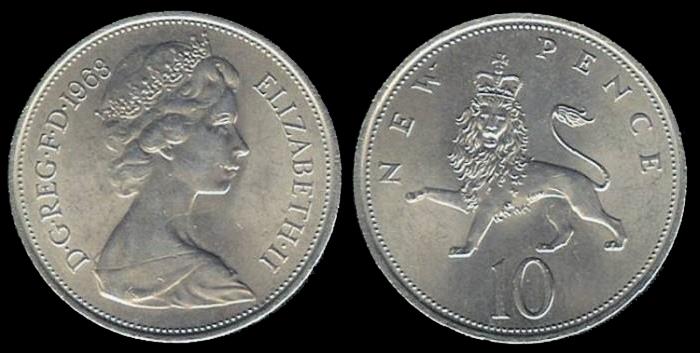








Designed by Nigel G Wilcox






The Paragon Of Metal Detecting
Powered By Sispro1
Ten Pence
British Decimal Currency - Numismatics,
Ten Pence 10p
Withdrawn from Circulation

Reduced Size and Current
Check the word 'New' Not on current 10 pence coins
The British decimal ten pence (10p) coin - often pronounced "ten pee" - was issued in 1968 in preparation for the 1971 decimalisation of the currency. At that time it had the same value, size, and weight as the existing florin (two-shilling coin), and it may be viewed as a continuation of the older coin. Between 1968 and 1971 it circulated, with a value of two shillings, alongside the pre-decimal two-shilling coins - the aim being to gradually familiarise the public with the new decimal coinage. After decimalisation the old two-shilling coins continued to circulate, with a value of 10p, until finally withdrawn in 1993.
The 10p coin is minted from a cupronickel alloy of 75% copper and 25% nickel. The 1968 version of the coin weighed 11.31 grams and had a diameter of 28.50 millimetres. In 1992 a smaller version weighing 6.50 grams and with a diameter of 24.50 millimetres was introduced. Apart from the reduction in size, the coin's design remained essentially unchanged. This downsizing took place a year after a similar reform of the five pence coin, and the new ten pence was in fact only a gram heavier and half a millimetre larger than the previously withdrawn five pence. All the older 10p and florin coins were withdrawn from circulation and demonetised from 1 July 1993. With the earlier withdrawal of the 5p and shilling coins, the 10p was the last of the "historical" coin sizes to be withdrawn.
Three different obverses have been used so far-from 1968 to 1984 the head of Queen Elizabeth II by Arnold Machin , from 1985 to 1997 the head by Raphael Maklouf , and since 1998 the head by Ian Rank-Broadley . In all cases, the inscription is ELIZABETH II D.G.REG.F.D. followed by the date.
Several varieties of the first small coin dated 1992 are known to exist. There are two varieties each of the obverse and reverse, and two of the edge, making five distinct types of which two are scarce.
As of December 2005 there were an estimated total 1,587 million 10p coins in circulation.
The 10p coin is minted from a cupronickel alloy of 75% copper and 25% nickel. The 1968 version of the coin weighed 11.31 grams and had a diameter of 28.50 millimetres. In 1992 a smaller version weighing 6.50 grams and with a diameter of 24.50 millimetres was introduced. Apart from the reduction in size, the coin's design remained essentially unchanged. This downsizing took place a year after a similar reform of the five pence coin, and the new ten pence was in fact only a gram heavier and half a millimetre larger than the previously withdrawn five pence. All the older 10p and florin coins were withdrawn from circulation and demonetised from 1 July 1993. With the earlier withdrawal of the 5p and shilling coins, the 10p was the last of the "historical" coin sizes to be withdrawn.
Three different obverses have been used so far-from 1968 to 1984 the head of Queen Elizabeth II by Arnold Machin , from 1985 to 1997 the head by Raphael Maklouf , and since 1998 the head by Ian Rank-Broadley . In all cases, the inscription is ELIZABETH II D.G.REG.F.D. followed by the date.
Several varieties of the first small coin dated 1992 are known to exist. There are two varieties each of the obverse and reverse, and two of the edge, making five distinct types of which two are scarce.
As of December 2005 there were an estimated total 1,587 million 10p coins in circulation.
For Reference ONLY
For Reference ONLY
Everything For The Detectorist
Copyright All Rights Reserved by Nigel G Wilcox E-Mail: ngwilcox100@gmail.com
6. Menu
Pages



Main Coin Menu
Decimal Coin Menu
Member NCMD























